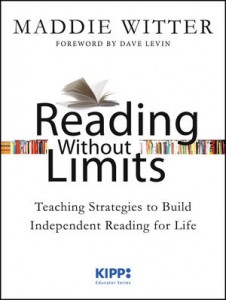How to Build Lifelong Readers
Reading Without Limits: Teaching Strategies to Build Independent Reading for Life
by Maddie Witter
(Jossey Bass, 2013 – Learn more)
A beginning teacher with little reading instruction training or a veteran teacher who needs a refresher will find useful guidance in Reading Without Limits: Teaching Strategies to Build Independent Reading for Life by Maddie Witter.
The book’s goal is to provide teachers with ideas to improve students’ reading levels so that they eventually become fluent adult readers. Witter meets her goal by demonstrating a simple approach with three requirements:
• access to free-choice in reading materials at students’ comfort levels;
• participation in shared reading of texts and assigned reading chosen by the teacher;
• guided reading in which students with similar abilities and/or reading instruction needs form small groups based on similar abilities and/or instructional needs to read selections together to build their literacy skills.

1. Launching Lifelong Readers
2. Steps to Creating Lifelong Readers
3. Putting the Power of Choice, Shared, and Guided Reading to Work in Your Classroom or School
4. Steps to Enhance Lifelong Readers
5. Putting It All Together
Each of the 15 chapters integrates practical, straight-forward explanations of strategies with examples and suggestions drawn from experience and observation in real classrooms as well as the professional literature. The “Reading Without Limits Teacher Checklist” concludes the introduction and provides a guide to implementing organized, effective reading instruction. References, Notes, and a very useful Index round out the book.
This book almost brought me out of retirement
Reading Without Limits provides a comfortable yet inspiring read that makes the strategies Witter presents so doable that the reader will want to immediately begin to plan instruction. Although I’m a recently retired teacher, I itched to try some of the strategies (reading this book almost brought me out of retirement several times).
My former colleagues and I would have found Chapter One especially invaluable. Some 12 years before I retired, under pressure to raise student performance on benchmark tests, my district directed all middle school English teachers to assess each student’s reading level in late fall and then again before the state’s Benchmark Test.
Administering the test to all our students individually confounded many English teachers. A brief “in-service” on how to administer and score an oral reading assessment — then administer the appropriate independent reading assessment — didn’t allay the stress. Hours of teachers’ planning time were spent on initial assessments, which weren’t completed until just a month before the big test and weren’t all that useful in planning instruction.
Too bad Witter’s book wasn’t available at the time, since Chapter One, “Finding Students’ Reading Levels,” describes and explains how to do just that — effectively and succinctly. From Vygotsky’s Zones through inventories and running records, Witter tells how a teacher can determine the reading level of each student in a timely way, match kids and books, and turn a classroom into a supportive reading community.
For a teacher blessed and stressed with students like those in my former classrooms, Chapter One alone is worth the price of this book—but that could be true of any other chapter, too.
Aha’s! and Oh Yeah’s!
As a retired English teacher, I found part of the enjoyment of Reading Without Limits came from the occasional “AHA!” moments when I recognized an instructional strategy I had used “back in the day” and realized why it had been effective.
I also remembered quite a few times when I struggled to keep students engaged with difficult texts. Chapter 4, “Shared Reading to Teach, Reinforce, and Challenge,” (for instance) inspired me to wish I could have a “do over” and try some of the strategies Witter describes. Throughout the book, Witter references various literacy instruction gurus for support or example, twice sending me to my bookshelf to find the original quote in a dog-earred book and leaving me wondering how I had missed seeing that useful bit when I most needed it.
Many ideas throughout this book will be familiar to teachers steeped in the reading/writing workshop canon and the Heinemann/Stenhouse stable of insightful authors on literacy instruction. Those books and others have clearly informed Witter’s practices. This savvy early 30-something teacher has integrated her and her colleagues’ experiences and practices with the most useful of commercial resources to produce a valuable guide for teachers committed to improving student literacy.
Reading Without Limits is just what the third or fourth year middle level teacher struggling with classrooms of students in the usual range of reading abilities needs. Teachers who use the book throughout the school year will be grateful for the index and references. A year or two with this book and the resources at the Reading Without Limits website to guide their work, and they’ll be ready for bigger doses of Fontas and Pinnell, Harvey Daniels, Stephanie Harvey, Jeff Wilhelm, Laura Robb, Carol Jago, Stephen Krashen, Lucy Calkins, Kylene Beers, and more.
As for me, I’m sending my review copy to a young middle school English teacher in a small Ozarks town tomorrow. And I just sent my MiddleWeb editor this note:
This book is a winner. It could easily replace a foot or 18 inches of shelf space stuffed with ‘professional’ books about literacy instruction that I hardly found time to read while teaching.”
Beverly Maddox taught in the middle and high school grades for 25 years and retired from the Little Rock (Arkansas) School System after coordinating the district’s AVID program during her final four years. Before becoming a teacher, she managed operations for a community action agency and directed a national US Department of Energy weatherization demonstration project. Bev Maddox has consulted in the areas of interdisciplinary teaching, reading, instructional planning, teaching research and information seeking skills, classroom management and parent-school relations.




































So great to see this coming out of KIPP. I wasn’t much of a reader as a kid, but now that I’ve been in the real-world for a couple years, I read every night. Can’t get enough of it!